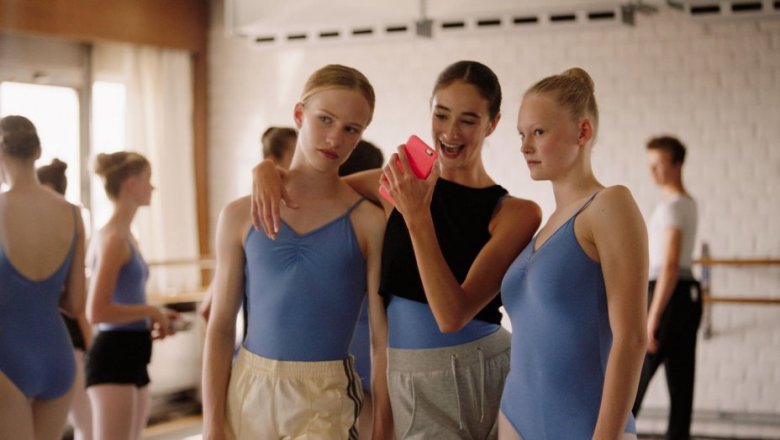|
Girl | Lukas Dhont | Belgium | 2018 Breathe in. Breathe out. Breathe in. Breathe out. Inhale. Exhale. Absorb. Expel. Hold your breath. Control. Sustain. Release. Lara, or rather ‘Lah-rah’ in the soft Belgian pronunciation, is an embodied whisper, there and yet not there, a name that is transient and belonging to the air. ‘Lah-rah,’ we hear her brother softly intone, ‘Lah-rah’, as her form fills the frame bathed in the quiet light of the morning sun. From the opening moments of the film, Lara (Victor Polster) is positioned as both single and double, an inhalation of breath and an exhalation, in and out, x and y, and x and x. But where her body protrudes and weeps and expels she longs for it to contain and invert and hold. Girl is a tender and evocative film that follows Lara as she trains as a ballet dancer while impatiently waiting for gender reassignment surgery and undergoing hormone therapy. Thwarted by her body—as a trans teen she has not received the same training in puberty or pointe-work as her other female peers—Lara struggles to breathe in her claustrophobic physicality and in spaces that are not designed to accommodate her. For the men around her, expressing is second nature, as her father spurts water from his mouth and her neighbour ejaculates in a clumsy exchange on the sofa. But for Lara, every exhalation she utters, like the blood that escapes from her feet and her genitals, is her body turning against her and turning her inside out. She does not want to be asked questions and she does not want to give information. She wants to keep it all, everything, emotion and body, inside of her. Her dance, as much as the medical care she receives, offers control as she struggles to reconcile her body and outward appearance with her sense of self. All the while, Lara must live liminally, in between. She is partially enrolled for ballet school to test her pointe work before full acceptance; she breathes through half-open windows; and she is allowed into, but exists on the margins of, the girls’ changing room. Dressed in delicate pastel clothes with soft textures of wool and silk, she does not conform to the hard lines and surfaces of the world around her. From the medicalised spaces of the hospital, with its clinical whiteness and sharp instruments, via the cold tiles of the kitchen apartment, to the stone walls and metal barre of the ballet school, her environments are inhospitable. And she is neither allowed to be out—being locked in at home when her health deteriorates—or in, as she is banished to a separate room at a girls’ sleepover. Throughout the film, we experience life as Lara, so that we understand the pain of misgendering (when her brother accidentally uses her dead name, Victor) and the torture of trans-misogyny. When a teacher asks Lara to close her eyes so that the other girls may raise their hands if they’re uncomfortable sharing a changing room with her, the camera focuses in on her face so that we, too, are kept in the dark about their choices. Like Lara, we are left out and unknowing. Similarly, at the sleep-over, Lara’s emotional distress is palpable as her so-called friends insist on seeing her genitals; a kind of loaded ‘I’ll show you mine if you show me yours’ that reveals the violence of looking that many women experience on a daily basis under patriarchy. That this violence is done to her by girls is all the more shocking. There are, perhaps unsurprisingly, problems with the film. I have major reservations about the casting and, indeed, the ownership of the gaze that lets us see into Lara’s world. While Dhont seems convinced that his ‘gender-blind’ casting solves the problem of patriarchy and transphobia, it is an oversight given how poorly trans people are represented onscreen, and I’m sure this will be a widespread criticism. And, as I write this review, Polster has been awarded Best Performance in the Un Certain Regard competition at Cannes. On the one hand, I don’t wish to undermine what is a truly astonishing turn from a young actor. With every gesture (and so much work is done by the mouth and the lips) Polster inhabits and expresses Lara and is magnetising to watch. On the other hand, as is so often the case, a cis-gender actor is receiving accolades for playing a trans part, and we should not be uncritical.
Additionally, the film at times slips into an all too objective mode of gazing at, rather than with, Lara and the teenage girls she hangs out with at the ballet school. Girl goes to great lengths to ensure that its viewers understand the physical and emotional challenges that Lara faces. However, lingering shots of her genitals and close-ups of her body in the mirror become uncomfortable. It is as if we have crossed a line, walked into her bedroom unannounced, and are invading her privacy. Similarly, the camera looks longingly at the pubescent bodies of the other girls, drawing attention to tits and arses and hair, especially in a bikini-clad under-water swimming pool scene. While this can be read as an attempt to let us into Lara’s psychological space—she does, after all, envy the girls their seemingly perfect bodies—the result is far messier. Girl is battling over a century of the cis-gender male gaze in cinema, and its attempts at subversion are not entirely successful. It leaves a somewhat bitter taste in the mouth as we become complicit, yet again, in fetishizing different kinds of female body onscreen. Where the film is successful is in creating visual parallels between Lara’s transition (her physically becoming a woman) and her status as already-woman. Throughout the film, we see her tucking, cutting and pricking her body. She tucks and tapes her penis and also repeatedly tucks her hair behind her ear in a soft yet anxiously rendered gesture. She is pricked by needles in her hormone therapy and also pricks her ears to pierce them. Consequently, Girl creates continuities between trans and cis experiences of womanhood, and is a reminder that all women face scrutiny and pain in a patriarchal society that demands femininity and perfection. Given the levels of trans-misogyny in British and other national presses, this is a pertinent and vital film that, like Lara’s dad and doctors, tells audiences that trans women are women. Some of the more extreme violence done to Lara’s body is hard to bear. Based on a true story, it is difficult to know what is ‘authentic’ in the narrative and what is produced for spectacle and effect, and there is a danger that the film serves as yet more misery porn in a canon of woeful and upsetting queer stories onscreen. It is certainly not an easy watch, and it is surely a more extreme transitioning tale than most. Although she poignantly tells her father: ‘I don’t want to be an example. I just want to be a girl,’ the film does not afford her this luxury. Nevertheless, despite its many imperfections, it is a sympathetic tale that never questions her gender. It invites us to inhale and exhale with Lara: to gasp, to cry, to laugh and to dance with her, and, in the end… to breathe a slow sigh of relief. It is an undeniably beautiful piece of cinema.
2 Comments
|
BlogArchives
November 2018
Categories
All
|


 RSS Feed
RSS Feed